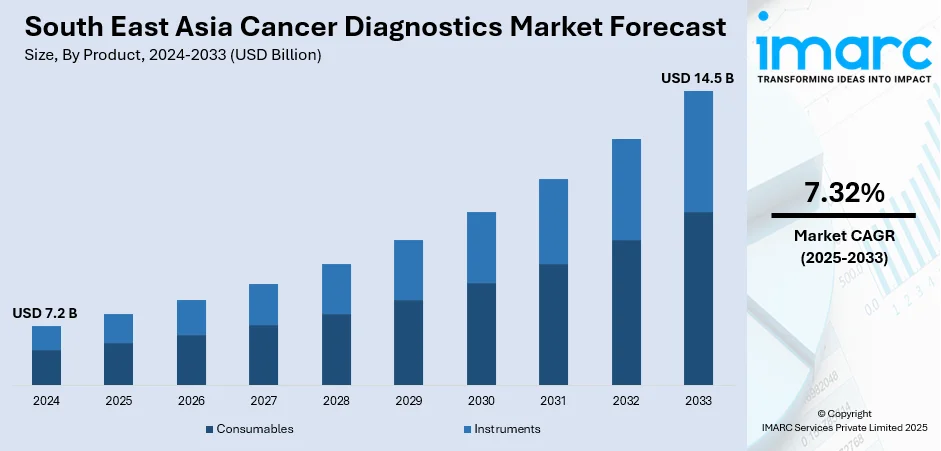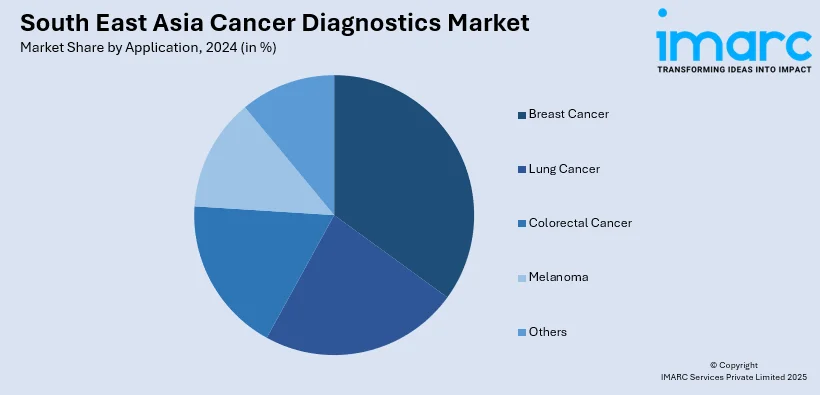
South East Asia Cancer Diagnostics Market Report by Product (Consumables, Instruments), Technology (IVD Testing, Imaging, Biopsy Technique), Application (Breast Cancer, Lung Cancer, Colorectal Cancer, Melanoma, and Others), End User (Hospitals and Clinics, Diagnostic Laboratories, and Others), and Country 2025-2033
Market Overview:
South East Asia cancer diagnostics market size reached USD 7.2 Billion in 2024. Looking forward, IMARC Group expects the market to reach USD 14.5 Billion by 2033, exhibiting a growth rate (CAGR) of 7.32% during 2025-2033. The continuous advancements in diagnostic technologies, such as next-generation sequencing, liquid biopsy, and molecular diagnostics, which help in enabling early detection and personalized treatment strategies, is driving the market.
|
Report Attribute
|
Key Statistics
|
|---|---|
|
Base Year
|
2024 |
|
Forecast Years
|
2025-2033
|
|
Historical Years
|
2019-2024
|
| Market Size in 2024 | USD 7.2 Billion |
| Market Forecast in 2033 | USD 14.5 Billion |
| Market Growth Rate (2025-2033) | 7.32% |
Cancer diagnostics play a pivotal role in the early detection and effective management of cancer, a complex group of diseases characterized by uncontrolled cell growth. These diagnostic tools encompass a range of techniques that enable healthcare professionals to identify and analyze abnormal cells or tumors within the body. From traditional methods like biopsies to cutting-edge technologies such as molecular profiling and liquid biopsy, cancer diagnostics have evolved significantly, allowing for more precise and personalized approaches to treatment. Early detection is crucial for successful cancer outcomes, as it facilitates timely intervention and enhances the chances of successful treatment. Diagnostic modalities like imaging, genetic testing, and blood markers contribute to a comprehensive understanding of the disease, aiding clinicians in tailoring therapeutic strategies. As research continues to advance, the landscape of cancer diagnostics is poised for further innovation, promising improved accuracy, efficiency, and accessibility in the ongoing battle against cancer.

To get more information on this market, Request Sample
South East Asia Cancer Diagnostics Market Trends:
The cancer diagnostics market in South East Asia is experiencing robust growth, primarily driven by advancements in technology and increased awareness. Firstly, the integration of cutting-edge diagnostic tools and techniques has significantly improved the accuracy and efficiency of cancer detection. Additionally, the rising prevalence of cancer serves as a compelling driver, necessitating the development and adoption of more sophisticated diagnostic solutions. Furthermore, a growing aging population contributes to the increased demand for cancer diagnostics, as age is a significant risk factor for various types of cancer. Moreover, the expanding scope of precision medicine and personalized treatment approaches fuels the demand for precise and early cancer diagnostics. Furthermore, collaborative efforts between healthcare organizations, research institutions, and industry players play a pivotal role in driving innovation in cancer diagnostics. Lastly, the emphasis on preventive healthcare and routine screenings further propels market growth, as early detection remains a key factor in improving cancer outcomes. In conclusion, a confluence of technological advancements, demographic trends, and collaborative initiatives converges to propel the cancer diagnostics market forward in South East Asia.
South East Asia Cancer Diagnostics Market Segmentation:
IMARC Group provides an analysis of the key trends in each segment of the market, along with forecasts at the regional and country level for 2025-2033. Our report has categorized the market based on product, technology, application, and end user.
Product Insights:
- Consumables
- Antibodies
- Kits and Reagents
- Probes
- Others
- Instruments
- Pathology-Based Instruments
- Imaging Instruments
- Biopsy Instruments
The report has provided a detailed breakup and analysis of the market based on the product. This includes consumables (antibodies, kits and reagents, probes, and others) and instruments (pathology-based instruments, imaging instruments, and biopsy instruments).
Technology Insights:
- IVD Testing
- Polymerase Chain Reaction (PCR)
- In Situ Hybridization (ISH)
- Immunohistochemistry (IHC)
- Next-Generation Sequencing (NGS)
- Microarrays
- Flow Cytometry
- Immunoassays
- Others
- Imaging
- Magnetic Resonance Imaging (MRI)
- Computed Tomography (CT)
- Positron Emission Tomography (PET)
- Mammography
- Ultrasound
- Biopsy Technique
A detailed breakup and analysis of the market based on the technology have also been provided in the report. This includes IVD testing (polymerase chain reaction (PCR), in situ hybridization (ISH), immunohistochemistry (IHC), next-generation sequencing (NGS), microarrays, flow cytometry, immunoassays, and others), imaging (magnetic resonance imaging (MRI), computed tomography (CT), positron emission tomography (PET), mammography, and ultrasound), and biopsy technique.
Application Insights:

- Breast Cancer
- Lung Cancer
- Colorectal Cancer
- Melanoma
- Others
The report has provided a detailed breakup and analysis of the market based on the application. This includes breast cancer, lung cancer, colorectal cancer, melanoma, and others.
End User Insights:
- Hospitals and Clinics
- Diagnostic Laboratories
- Others
A detailed breakup and analysis of the market based on the end user have also been provided in the report. This includes hospitals and clinics, diagnostic laboratories, and others.
Country Insights:
- Indonesia
- Thailand
- Singapore
- Philippines
- Vietnam
- Malaysia
- Others
The report has also provided a comprehensive analysis of all the major regional markets, which include Indonesia, Thailand, Singapore, Philippines, Vietnam, Malaysia, and Others.
Competitive Landscape:
The market research report has also provided a comprehensive analysis of the competitive landscape in the market. Competitive analysis such as market structure, key player positioning, top winning strategies, competitive dashboard, and company evaluation quadrant has been covered in the report. Also, detailed profiles of all major companies have been provided.
South East Asia Cancer Diagnostics Market Report Coverage:
| Report Features | Details |
|---|---|
| Base Year of the Analysis | 2024 |
| Historical Period | 2019-2024 |
| Forecast Period | 2025-2033 |
| Units | Billion USD |
| Scope of the Report | Exploration of Historical and Forecast Trends, Industry Catalysts and Challenges, Segment-Wise Historical and Predictive Market Assessment:
|
| Products Covered |
|
| Technologies Covered |
|
| Applications Covered | Breast Cancer, Lung Cancer, Colorectal Cancer, Melanoma, Others |
| End Users Covered | Hospitals and Clinics, Diagnostic Laboratories, Others |
| Countries Covered | Indonesia, Thailand, Singapore, Philippines, Vietnam, Malaysia, Others |
| Customization Scope | 10% Free Customization |
| Post-Sale Analyst Support | 10-12 Weeks |
| Delivery Format | PDF and Excel through Email (We can also provide the editable version of the report in PPT/Word format on special request) |
Key Questions Answered in This Report:
- How has the South East Asia cancer diagnostics market performed so far and how will it perform in the coming years?
- What is the breakup of the South East Asia cancer diagnostics market on the basis of product?
- What is the breakup of the South East Asia cancer diagnostics market on the basis of technology?
- What is the breakup of the South East Asia cancer diagnostics market on the basis of application?
- What is the breakup of the South East Asia cancer diagnostics market on the basis of end user?
- What are the various stages in the value chain of the South East Asia cancer diagnostics market?
- What are the key driving factors and challenges in the South East Asia cancer diagnostics?
- What is the structure of the South East Asia cancer diagnostics market and who are the key players?
- What is the degree of competition in the South East Asia cancer diagnostics market?
Key Benefits for Stakeholders:
- IMARC’s industry report offers a comprehensive quantitative analysis of various market segments, historical and current market trends, market forecasts, and dynamics of the South East Asia cancer diagnostics market from 2019-2033.
- The research report provides the latest information on the market drivers, challenges, and opportunities in the South East Asia cancer diagnostics market.
- Porter's five forces analysis assist stakeholders in assessing the impact of new entrants, competitive rivalry, supplier power, buyer power, and the threat of substitution. It helps stakeholders to analyze the level of competition within the South East Asia cancer diagnostics industry and its attractiveness.
- Competitive landscape allows stakeholders to understand their competitive environment and provides an insight into the current positions of key players in the market.
Need more help?
- Speak to our experienced analysts for insights on the current market scenarios.
- Include additional segments and countries to customize the report as per your requirement.
- Gain an unparalleled competitive advantage in your domain by understanding how to utilize the report and positively impacting your operations and revenue.
- For further assistance, please connect with our analysts.
 Request Customization
Request Customization
 Speak to an Analyst
Speak to an Analyst
 Request Brochure
Request Brochure
 Inquire Before Buying
Inquire Before Buying




.webp)




.webp)












